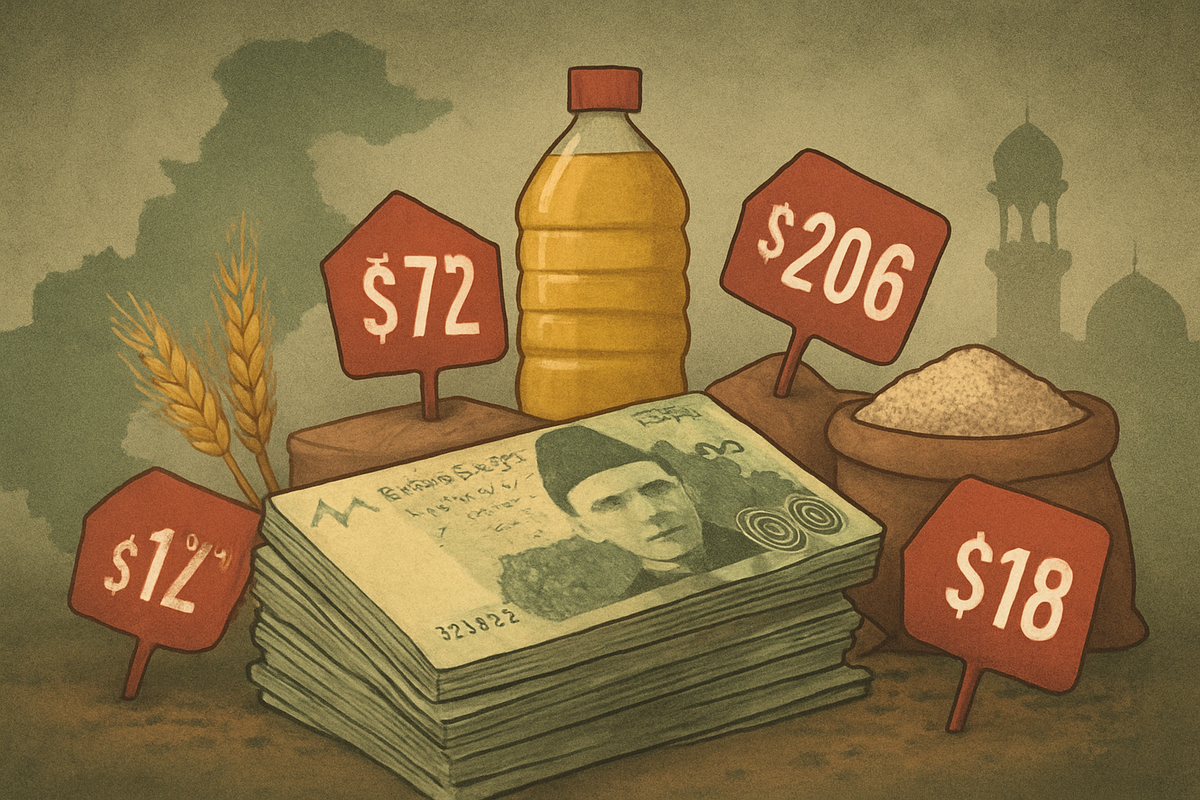
Pakistan is once again facing an uphill battle against inflation, with recent data revealing a concerning uptick in price pressures across the nation. The country's national weekly inflation has reportedly risen by 0.73%, pushing the annual inflation rate to 4.32%. This surge is largely driven by the escalating prices of various essential commodities, immediately impacting the purchasing power of average citizens and posing significant challenges for the broader economy.
The immediate implications of this inflationary trend are profound. Consumers are experiencing a tangible erosion of their purchasing power, leading to a higher cost of living as essential goods become increasingly unaffordable. This burden falls disproportionately on vulnerable populations, exacerbating financial insecurity. For businesses, particularly small and medium-sized enterprises (SMEs), rising commodity prices translate into increased production costs, threatening their viability. Furthermore, Pakistan's reliance on imports means that currency depreciation exacerbates these costs, creating a complex web of economic challenges for government policymakers striving for stability and growth.
Detailed Coverage of the Event
The current inflationary wave in Pakistan is broad-based, with specific commodities acting as primary drivers. Food items have seen some of the most dramatic increases, with tomatoes surging by an astounding 126.96% in October 2025, sugar by 34.83%, and wheat by 22.56%. Other staples like beef (up 13.45% year-on-year in November 2025) and various pulses and edible oils have also contributed significantly to the rising food basket costs. Beyond food, energy prices are a major factor; electricity tariffs increased by over 11% for low-income consumers in November 2025, while LPG prices rose by 5.16% weekly in the same month, alongside consistent hikes in diesel and petrol prices.
This inflationary spiral is not an isolated event but rather the latest chapter in a turbulent economic timeline for Pakistan. Inflation started to gather pace around 2020, with a notable acceleration from late 2021. The period of FY22 (July 2021 - June 2022) saw the State Bank of Pakistan (SBP) begin raising its policy rate in response to growing inflationary pressures and a widening current account deficit, compounded by the global commodity price shock from the Russian invasion of Ukraine and devastating domestic floods in 2022. The crisis deepened in FY23 (July 2022 - June 2023), with inflation peaking at an unprecedented 37.97% in May 2023 – the highest in decades. This period was marked by aggressive monetary tightening by the SBP, significant rupee depreciation, and increased taxation. While FY24 and the first half of FY25 saw a dramatic disinflationary trend, reaching a multi-decade low of 0.3% in April 2025, the recent acceleration to 6.2% in October 2025 signals renewed pressures, largely due to food supply disruptions caused by floods and border closures.
Key players involved in navigating this economic landscape include the State Bank of Pakistan (SBP), which is responsible for monetary policy and has maintained its policy rate at 11% since June 2024, aiming to anchor inflation expectations. The Ministry of Finance handles fiscal policy and government spending, regularly releasing economic outlook reports. Crucially, the International Monetary Fund (IMF) remains a significant external partner, providing financial assistance and structural reform recommendations that often come with strict conditions.
Initial reactions from the Pakistan Stock Exchange (PSX) have been mixed. Despite periods of extreme inflation, the benchmark KSE-100 index displayed remarkable resilience in 2023 and 2024, surging by over 50% and 80% respectively, reaching record highs. This performance was largely attributed to sharp interest rate cuts, a strengthening rupee, and the disbursement of IMF loans. However, the market has shown sensitivity to recent inflation news, with the equity market falling in November 2025 following the higher-than-expected October inflation print. Industries like banking benefited from higher interest margins, while export-oriented sectors such as textiles and IT saw gains from rupee devaluation. Conversely, consumer-dependent sectors faced headwinds, and some auto manufacturers, like Honda Atlas Cars Pakistan (PSX: HCAR), reportedly considered plant shutdowns due to rising costs and reduced demand.
Companies in the Crosshairs: Winners and Losers from Inflation
The current inflationary environment, fueled by rising commodity prices and currency depreciation, presents a dual-edged sword for public companies listed on the Pakistan Stock Exchange (PSX). While some sectors are poised to suffer from increased input costs and dampened consumer demand, others may find opportunities through pricing power, export advantages, or interest rate differentials.
Companies in the manufacturing sector are particularly vulnerable. Cement producers, such as Lucky Cement (PSX: LUCK) and DG Khan Cement (PSX: DGKC), face significantly higher production costs due to their heavy reliance on imported coal and rising domestic electricity tariffs. Similarly, textile companies like Nishat Mills (PSX: NML) and Gul Ahmed Textile Mills (PSX: GATM), despite some being export-oriented, are impacted by increased global cotton prices and Pakistan's high energy tariffs, which erode their competitiveness. Automobile assemblers, including Indus Motor Company (PSX: INDU) and Pak Suzuki Motor Company (PSX: PSMC), suffer from expensive imported components due to currency depreciation and reduced consumer purchasing power, leading to declining sales. Food processors, such as National Foods (PSX: NATF) and Engro Foods (PSX: EFOODS), also contend with higher agricultural raw material costs and energy expenses. Generally, companies producing non-essential consumer goods are likely to see reduced demand as households prioritize basic necessities.
Conversely, certain sectors are better positioned to navigate, or even benefit from, the inflationary pressures. The energy sector, specifically oil and gas exploration and production (E&P) companies like Oil and Gas Development Company Ltd (PSX: OGDCL), Pakistan Petroleum Limited (PSX: PPL), and Mari Petroleum Company Limited (PSX: MARI), can see increased revenues. Their earnings, often pegged to international dollar-denominated benchmarks, translate into significantly higher local currency income when global oil and gas prices rise, especially with a depreciating rupee.
The finance sector also stands to gain. Commercial banks, including Meezan Bank (PSX: MEBL), United Bank Limited (PSX: UBL), and Bank Alfalah (PSX: BAFL), can benefit from higher Net Interest Margins (NIMs) when the State Bank of Pakistan raises policy rates to combat inflation, as their lending rates typically adjust faster than deposit rates. However, this comes with the caveat of potential increases in non-performing loans if economic slowdowns affect borrowers' ability to repay. Furthermore, export-oriented companies benefit significantly from currency depreciation. Textile exporters like Interloop Limited (PSX: ILP) and Kohinoor Textile Mills Limited (PSX: KOTM), and particularly IT and software export companies such as Systems Limited (PSX: SYS), whose revenues are earned in foreign currencies, see their local currency earnings boosted, providing a natural hedge against domestic inflation. Pharmaceutical companies, dealing in essential goods, often possess some pricing power, allowing them to mitigate rising input costs to a certain extent.
Broader Economic Canvas: Wider Significance and Global Context
Pakistan's recent inflation trajectory, characterized by a dramatic surge to 38% in May 2023—its highest in 30 years—followed by an equally sharp decline to 0.3% by April 2025, and a subsequent uptick to 6.2% in October 2025, reflects a complex interplay of domestic and global factors. The initial peak was driven by political turmoil, currency depreciation, low foreign exchange reserves, and global commodity price shocks exacerbated by the Russia-Ukraine conflict and devastating 2022 floods. The subsequent disinflationary phase was largely attributed to a high base effect, a tight monetary policy by the SBP, easing global oil prices, and a relatively stable exchange rate. This period of disinflation broadly aligned with a wider trend across South Asia, where countries like India (4.4%) and Bangladesh (9.7%) also saw moderated inflation in early 2024. Globally, inflation is forecast to decline steadily from 6.8% in 2023 to 4.5% in 2025. However, Pakistan's recent acceleration to 6.2% in October 2025 suggests a potential divergence from this consistent global disinflationary path, highlighting its unique vulnerabilities.
The ripple effects of Pakistan's economic instability and inflation can extend to its neighboring economies. High inflation and a volatile Pakistani Rupee can reduce its purchasing power for imports, impacting exports from trading partners like China, India, Afghanistan, and Iran. Historically, Pakistan has been a significant trading partner for Afghanistan, but political tensions and border closures have led Afghanistan to increasingly reroute its commerce through Iran and India, affecting Pakistan's exports and transit fees. While formal trade with India is limited, any significant economic downturn in Pakistan could still have minor regional trade implications and, more broadly, impact regional stability if social and political unrest were to escalate.
The State Bank of Pakistan (SBP) has played a crucial regulatory role, implementing an aggressive monetary policy response during the peak inflation period, raising its policy rate to an all-time high of 22% in June 2023. As inflation eased, the SBP initiated rate cuts, bringing the policy rate down to 11% by October 2025, where it has been held steady. The SBP aims to stabilize inflation within a medium-term target range of 5-7% by the end of FY25, but acknowledges that core inflation remains "sticky" (9.7% in November 2024) and inflation expectations are volatile. This underscores the need for continued fiscal consolidation and structural reforms to complement monetary policy efforts.
Historically, Pakistan has battled recurrent episodes of high inflation, with four major periods where annual inflation consistently exceeded 7% for more than three consecutive years (FY73-FY78, FY89-FY98, FY05-FY15, and the ongoing FY20-H1FY24 episode). Common drivers across these periods include fiscal deficits, external borrowing, currency depreciation, global commodity prices, political instability, and supply disruptions. These historical precedents, coupled with lessons from other developing economies, emphasize that sustained high inflation is often linked to lower growth, financial crises, weak investor confidence, and disproportionately harms the poor. Effective control requires a robust policy framework encompassing fiscal discipline, central bank independence, and comprehensive structural reforms.
The Road Ahead: Navigating Pakistan's Economic Future
The future outlook for Pakistan's economy presents a delicate balance of ongoing challenges and emerging opportunities. In the short term, inflation is projected to see a slight uptick, with estimates for November 2025 ranging from 6.5% to 7.0% year-on-year, primarily due to persistent food supply disruptions from recent floods and border closures, alongside energy price adjustments. However, global commodity markets are generally exhibiting a disinflationary trend, which could offer some respite. Looking further ahead, the International Monetary Fund (IMF) projects Pakistan’s CPI-based inflation to gradually decline to 9.5% in 2025 and further to 6% in the 2025–26 fiscal year, aligning with the State Bank of Pakistan’s (SBP) medium-term target band of 5–7%.
Economically, Pakistan is showing signs of recovery. Real GDP growth is estimated at 2.6% in FY25, supported by robust private consumption, investment, and significant remittance inflows. The Large-Scale Manufacturing (LSM) sector recorded a growth of 4.1% during the first quarter of FY26 (July-September), indicating revitalization across various industries. For long-term sustainability, the IMF projects GDP growth to improve to 3.2% in 2025 and 4% by 2026, contingent on the successful implementation of critical structural reforms. This necessitates a fundamental pivot from short-lived, consumption-led growth towards a model centered on productivity and socioeconomic development.
Strategic pivots are crucial for both the government and businesses. The government must prioritize policy continuity, consistent implementation of reforms, and a decisive shift towards a globally competitive, export-driven economic model to break Pakistan's recurring boom-bust cycles. This includes maintaining fiscal discipline, increasing the tax-to-GDP ratio, reforming the energy sector, and enhancing the SBP's monetary policy framework to focus on longer-term projections and core inflation. For businesses, adapting to global standards, integrating into international value chains, and modernizing production processes are essential. Developing export components across all industries and leveraging opportunities in digitalization and the green transition will be vital for sustainable growth.
Market opportunities exist in revitalizing sectors like manufacturing and agriculture, which are undergoing mechanization booms. Export-oriented industries, including textiles and IT services, are poised for growth, particularly with the potential for increased foreign investment in energy, mining, and technology sectors. Real estate can also serve as an inflation hedge. However, significant challenges persist, including a weak currency, high external debt, balance of payments deficits, supply-side shocks, global commodity price volatility, and political uncertainty. High borrowing costs and a narrow export base further constrain growth. Potential scenarios range from an optimistic outcome of sustained reform leading to controlled inflation and accelerated GDP growth, to a moderate path of continued stabilization with cyclical volatility, or a pessimistic scenario of economic downturn and stagflation if critical reforms fail and external shocks intensify.
Investor's Compass: A Comprehensive Wrap-up
Pakistan's current inflationary landscape, with an annual inflation rate of 6.2% in October 2025, marks the highest in a year, largely propelled by soaring food prices for commodities like tomatoes, sugar, and wheat, exacerbated by floods and border closures. Broader price increases in housing, transport, and clothing, coupled with rising core inflation, underscore persistent underlying price pressures. While this is a notable concern, it represents a significant de-escalation from the record peak of 37.97% observed in May 2023, reflecting ongoing efforts towards economic stabilization.
Moving forward, investors must keep a close eye on several critical market indicators. The State Bank of Pakistan (SBP) has maintained its benchmark policy rate at 11% since June 2024, and its upcoming Monetary Policy Committee (MPC) meetings (scheduled for December 15, 2025, and January 26, 2026) will be pivotal. While the SBP aims for inflation to largely remain within its 5-7% target range for fiscal year 2025-26, the high real interest rate (currently around 7.5-7.8%) remains a concern for business investment and competitiveness. Any sustained decline in core inflation could signal room for future rate adjustments.
Global commodity prices offer a glimmer of hope, with the World Bank projecting a five-year low in 2025 and a six-year low in 2026 for overall commodity prices, driven by subdued global economic growth and an oil surplus. Energy prices are expected to decline by 6% in 2025 and food prices by 4%, which would be significantly favorable for Pakistan as a net importer. However, a projected 21% surge in fertilizer prices for 2025 warrants close monitoring. Investors should also track global geopolitical developments, as these can swiftly reignite commodity price volatility and disrupt supply chains.
The government's commitment to an export-led, investment-driven growth strategy, supported by broad reforms across key sectors and a commendable primary fiscal surplus, is crucial for sustaining positive market sentiment. The ongoing IMF-backed reforms are vital for economic stabilization and boosting investor confidence. The successful implementation and effectiveness of these reforms, particularly those aimed at improving the business environment and managing the fiscal deficit, will dictate the pace and resilience of Pakistan's economic recovery. Political stability, which has seen some improvement, will also be key to maintaining investor confidence.
In conclusion, the current inflationary period, while not as severe as previous peaks, highlights the enduring challenge of achieving price stability in Pakistan. Sustained high inflation erodes purchasing power, disproportionately impacts low-income households, and can hinder long-term economic growth. The concerted efforts by the SBP and the government to implement prudent monetary and fiscal policies, coupled with structural reforms, are essential for anchoring inflation expectations and fostering sustainable economic development. The positive investor sentiment recently observed in the Pakistan Stock Exchange reflects a belief in the country's economic recovery trajectory, provided that reforms continue and global economic conditions remain favorable. Investors should remain vigilant, closely monitoring policy decisions, global commodity trends, and the effectiveness of reforms to navigate the evolving market landscape in the coming months.
This content is intended for informational purposes only and is not financial advice




